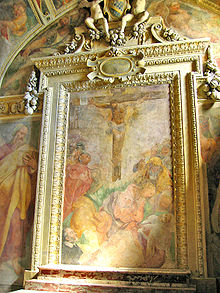
Santa Maria della Consolazione
Encyclopedia

Rome
Rome is the capital of Italy and the country's largest and most populated city and comune, with over 2.7 million residents in . The city is located in the central-western portion of the Italian Peninsula, on the Tiber River within the Lazio region of Italy.Rome's history spans two and a half...
at the foot of the Palatine Hill
Palatine Hill
The Palatine Hill is the centermost of the Seven Hills of Rome and is one of the most ancient parts of the city...
, in rione Campitelli
Campitelli
Campitelli is the X rione of Rome. In the logo there is the black head of a dragon on a white background. This symbol comes from the legend that Pope Silvester I threw out a dragon staying in the Forum Romanum.-External links:*...
.
History
The church is named after an icon of the Virgin Mary which was placed on this site to console criminals who were tossed down off the cliff above the church, thought to be the Tarpeian RockTarpeian Rock
The Tarpeian Rock was a steep cliff of the southern summit of the Capitoline Hill, overlooking the Roman Forum in Ancient Rome. It was used during the Roman Republic as an execution site. Murderers, traitors, perjurors, and larcenous slaves, if convicted by the quaestores parricidii, were flung...
from where condemned Roman criminals were tossed to their death in Roman times. In 1385 a condemned nobleman, Giordanello degli Alberini, paid 2 gold florins for the icon to provide consolation for criminals facing death.
Architecture and art

Martino Longhi the Elder
Martino Longhi the Elder was an Italian architect, the father of Onorio Longhi and the grandfather of Martino Longhi the Younger.He was born in Viggiù into a family of architects, and initially worked in Germany for the Altemps family, who were relatives of the Milanese Borromeo...
, during which time the Mannerist
Mannerism
Mannerism is a period of European art that emerged from the later years of the Italian High Renaissance around 1520. It lasted until about 1580 in Italy, when a more Baroque style began to replace it, but Northern Mannerism continued into the early 17th century throughout much of Europe...
façade was installed. The tympanum
Tympanum (architecture)
In architecture, a tympanum is the semi-circular or triangular decorative wall surface over an entrance, bounded by a lintel and arch. It often contains sculpture or other imagery or ornaments. Most architectural styles include this element....
was completed in 1827 by Pasquale Belli.
The first chapel on the right has frescoes of Scenes of the Passion (1556) by Taddeo Zuccari
Taddeo Zuccari
Taddeo Zuccari was an Italian painter, one of the most popular members of the Roman mannerist school.-Biography:...
. The second chapel has a Madonna with Christ-child and Saints (1575) by Livio Agresti
Livio Agresti
Livio Agresti , also called Ritius or Ricciutello, was an Italian painter of the late-Renaissance or Mannerist period, active both in his native city of Forlì and in Rome, where he died. He was one of the members of the "Forlì painting school"...
. The third chapel has a Story of Jesus and Virgin by Giovanni Baglione
Giovanni Baglione
Giovanni Baglione was an Italian Late Mannerist and Early Baroque painter and art historian. He is best remembered for his acrimonious involvement with the artist Caravaggio and his writings concerning the other Roman artists of his time.-Early life:A pupil of Francesco Morelli, he worked mainly...
. The chapel to the right of the presbitery has an icon of mary from the 13th century. The altar, designed by Martino Loghi, has a fresco copy of the 14th century Madonna della Consolazione repainted by Antoniazzo Romano
Antoniazzo Romano
Antoniazzo Romano, born Antonio di Benedetto Aquilo degli Aquili was an Italian Early Renaissance painter, the leading figure of the Roman school during the 15th century.-Biography:...
. The walls of the presbitery are frescoed with a Nativity and an Assumption by Niccolò Circignani
Niccolò Circignani
Niccolò Circignani was an Italian painter of the late-Renaissance or Mannerist period.Born in Pomarance, he is one of three Italian painters called Pomarancio. His first works are documented from the 1560s, where he painted frescos on the Old Testament stories for the Vatican Belvedere, where he...
(il Pomarancio), who also painted the Scenes of the life of Mary and Jesus in the fifth chapel. The 4th chapel to the left has Life of St. Andrew frescoes by Marzio Colantonio Ganassini. In the 3rd chapel on the left, are frescoes of scenes from the life of the Virgin
Life of the Virgin
The Life of the Virgin, showing narrative scenes from the life of Mary, the mother of Jesus, is a common subject for pictorial cycles in Christian art, often complementing, or forming part of, a cycle on the Life of Christ. In both cases the number of scenes shown varies greatly with the space...
by Francesco Nappi; the 2nd chapel on the left has a St. Francis receives the stigmata of the 17th century; the 1st chapel has a Mystical marriage of St. Catherine (c. 1530), a marble relief by Raffaello da Montelupo
Raffaello da Montelupo
Raffaello da Montelupo , born Raffaele Sinibaldi, was a sculptor and architect of the Italian Renaissance, and an apprentice of Michelangelo. He was the son of another Italian sculptor, Baccio da Montelupo...
.

